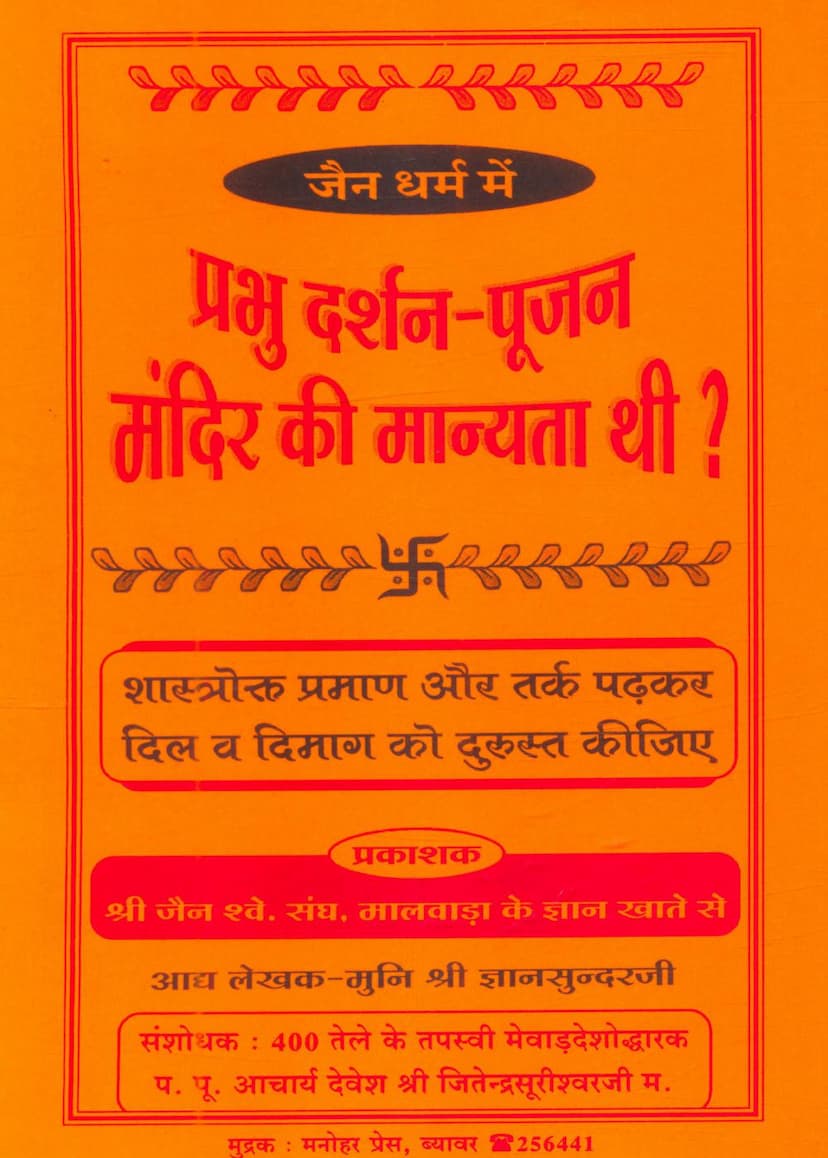Jain Dharm Me Prabhu Darshan Pujan Mandirki Manyata Thi
Added to library: September 1, 2025

Summary
Here's a comprehensive summary of the Jain text "Jain Dharm Me Prabhu Darshan Pujan Mandirki Manyata Thi" (Is there a tradition of Lord's Darshan, Worship, and Temples in Jainism?):
This book, authored by Muni Gyansundarmuni and revised by Acharya Jitesundrisuriji Maharaj, argues strongly in favor of the validity and importance of idol worship, temple visits, and associated practices within Jainism. It addresses common arguments against these practices, particularly from the perspective of groups like the Sthanakvasis and Terapanthis, and defends them using scriptural evidence and logical reasoning.
Key Themes and Arguments:
- Scriptural Basis for Idol Worship: The central thesis is that idol worship (Prabhu Darshan, Pujan) and temples (Mandir) are not only accepted but are integral to Jain tradition and supported by the scriptures themselves. The book posits that the scriptures are, in a sense, the "murti" (form/idol) of the Tirthankaras, and therefore, venerating them is natural. It claims that all 11 Angas, 32 Sutras, and 84 Agamas contain references to or principles that support the concept of "murti" or "pratima."
- "Murti" as "Sthapana" (Establishment/Representation): The author explains that idols are "Sthapana Nakshep," meaning they are representations or establishments of the Tirthankaras. Similarly, the scriptures are also considered "Sthapana" of the Tirthankaras' teachings. Therefore, both are worthy of veneration and worship.
- Benefits of Idol Worship: The book asserts that worshipping idols leads to spiritual development (Atma Kalyan), purification of thoughts (Chitt ki Nirmalta), and ultimately, liberation (Moksha). It argues that idols serve as a nimitta karan (instrumental cause) for developing devotion and remembrance of the Tirthankaras' virtues.
- Addressing Common Objections: The book systematically addresses numerous objections raised by those who oppose idol worship and temples:
- "Idols are inanimate/stone": The author counters that inanimate objects can still be powerful focal points for spiritual realization, citing examples like maps helping understand geography or photographs reminding one of loved ones. The "spirit" or "virtues" of the Tirthankara are imbued in the idol through faith and devotion.
- "Temples are built with worldly wealth and involve 'arambh' (creation/activity)": The book defends the use of wealth for temples as a righteous expenditure that benefits many. It argues that the "arambh" in temples is minimal compared to worldly activities and that the spiritual benefits far outweigh any perceived harm. It also points out the hypocrisy of those who preach against "arambh" in temples but engage in similar or greater activities in their own spiritual pursuits.
- "Idols are disrespected by animals, thieves, etc.": This is explained as a manifestation of the Tirthankaras' vitaragta (non-attachment). Their indifference to external disrespect is a sign of their perfect equanimity, mirroring the Tirthankaras' own equanimity when facing external actions.
- "No one attained Moksha solely by idol worship": The book clarifies that idol worship is a crucial means and a necessary component for achieving Moksha, alongside other practices like penance (Tapa) and self-control (Sanyam). It argues that all liberated souls in human or divine realms have engaged in idol worship.
- "Tirthankaras were renunciates, so why adorn their idols?": The author argues that the adornments in temples are not for the Tirthankaras' personal enjoyment but are expressions of devotion by their followers. They are symbolic of the Tirthankaras' glorious status and the reverence they command.
- "Why worship idols when scriptures are available?": The book emphasizes that both scriptures and idols serve as "Sthapana" and that different individuals may connect with the divine through different means. It highlights that seeing a map can be more effective than reading a description of a place.
- "Lords are beyond attachment, so why worship them?": The author stresses that the worship is not based on the idol having attachments but on the devotee's internal connection and devotion to the Tirthankara's virtues.
- "What about the four Naksheps (categories of existence)?": The book explains that while "Bhav Nakshep" (the actual spiritual state) is important, "Nam Nakshep" (name) and "Sthapana Nakshep" (representation/idol) are also venerated, especially when they lead to "Bhav Nakshep."
- "The tradition of not accepting idols originated with Lokashah": The book asserts that Lokashah was the first significant figure who challenged idol worship after Lord Mahavir, and that for 2000 years prior, all influential Acharyas and followers were temple-goers and idol worshippers.
- Historical Evidence: The book presents historical evidence, including inscriptions and archaeological findings, to support the ancient origins of temple building and idol worship in Jainism, dating back to the time of Lord Mahavir and even earlier.
- Critique of Anti-Idol Groups: The author points out the inconsistencies in the arguments of those who oppose idol worship, often showing how they themselves engage in similar practices or have practices that are arguably more problematic from an ahimsa perspective.
- The Importance of Temples: The book concludes by highlighting the numerous benefits of Jain temples for individuals and society, including fostering moral conduct, accumulating merit, preserving tradition, promoting unity, and serving as spiritual sanctuaries.
In essence, the book is a robust defense of the traditional Jain practices of idol worship and temple veneration, positioning them as scripturally sanctioned, spiritually beneficial, and historically deeply rooted within Jainism. It aims to clarify misunderstandings and strengthen faith in these practices.